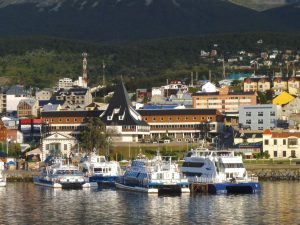In the eastern division, the Argentine government has promoted development by offering substantial financial inducements to people to settle and work in this region, one that diplays relatively cold weather and long, dark winter nights. A good example of the success of the plan is Ushuaia, a settlement squeezed into space bordering the Beagle Channel. Starting with a town of only around 12,000 residents the population has now increased to a city over 60,000, and as this is a port of call, or the jumping-off site, for ships heading to and from the Southern Ocean and the Antarctic Peninsula, it is bustling with visitors in the summer months. Over 200 cruise ships dock here anually.

Ushuaia City on the Beagle Channel marks the southern border of the island.
These days tourism is a major economic driving force here and records show that back in 2015 over 300,000 visitors arrived on the island, the majority (55%) from Argentina. Numerous other business activities are promoted in this eastern part of the island including extracting oil and gas, as well as peat ‘mining,’ and logging. In addition, factories that produce textiles and plastics have been constructed in economic free zones while raising beef cattle is important as this region is free of hoof-and-mouth disease.
As with most mountainous tracts, foothill areas rise up on both sides of the main spine and each altitude level comes with distinct biological constituents. In the case of Tierra del Fuego the eastern foothills of the Darwin Range lie on the dry side where the lower slopes are home to a variety of herbaceous plants including beach strawberry (Fragaria chiloensis) and calafate (Berberis buxifolia), both of which were gathered by the Yaghans for food. Stands of trees grow where conditions allow, and among these is the conifer,Pilgerodendron uviferumin the cypress family, the southernmost cone-bearing plant in the world and one often found in association with subpolar beeches, Nothofagus sp., and Winter Bark,Drimys winteri, the bark used by early travelers to prevent scurvy.
